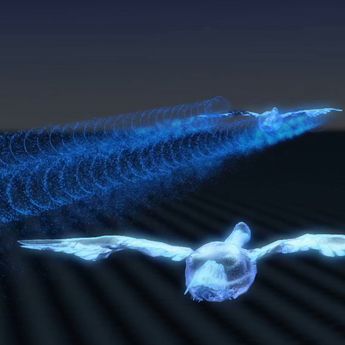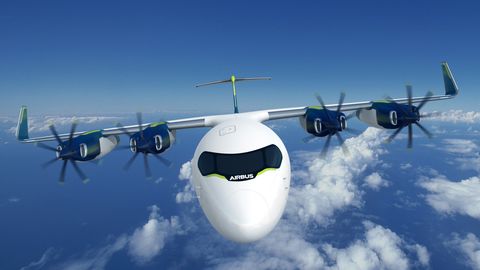Investigating the potential of paired flight
BIOMIMICRY IN ACTION
fello’fly and GEESE are two wake energy retrieval (WER) collaborative programmes led by Airbus. WER operations draw inspiration from the V-shaped flight pattern of migrating geese, who surf the air upwash, or updraft, of the leading bird. When applied to commercial aircraft operations, WER enables one aircraft to benefit from free lift from the air upwash of another, resulting in less engine thrust and therefore reduced fuel consumption.
fello’fly aims to define and demonstrate the technical, operational and commercial viability of two aircraft flying close together during a long-haul flight. The potential to reduce fuel consumption of commercial aircraft flying in this configuration was substantiated during the fello’fly long-haul flight test, which took place in 2021. GEESE builds upon this proof of concept and seeks to validate the operational feasibility of using WER operations for both transatlantic and inter-continental European flights.The project will run until mid-2026.

Assessing the safety and feasibility of paired flight
fello’fly was hosted by Airbus UpNext from 2019 to 2021. It culminated with a long-haul formation flight of two A350 aircraft, which flew three kilometres apart during the journey between Toulouse, France, and Montreal, Canada. A technical solution developed by Airbus ensured that the two aircraft remained safely positioned at a steady altitude. Results showed that CO2 emissions were reduced by 6 tonnes, confirming the potential for up to 5% fuel savings on long-haul flights.

Taking inspiration from migrating geese
Building on the success of fello’fly, GEESE was launched in 2023 as an Airbus-led, EU-funded project that is part of the SESAR 3 joint undertaking. Its purpose is to investigate how we can enable and scale WER operations from an air traffic management perspective. The project will further analyse safety aspects of paired flight, as well as possible impacts on legacy systems, potential non-CO2 emissions reductions, and operational solutions for expanding WER operations.
Collaborating across the aviation industry
Both fello’fly and GEESE were made possible due to a concentrated and sustained commitment by key aviation stakeholders to WER research.
The initial testing phase of fello’fly was supported by airline partners Frenchbee and Scandinavian airlines (SAS), as well as air traffic control partners in France, the UK, Canada and Ireland. Airbus is continuing fello’fly testing with the support of the DGAC, the French Civil Aviation Authority.
GEESE is part of the SESAR 3 joint undertaking. Led by Airbus and funded by Horizon Europe, the European Union’s scientific research initiative, the project counts a plethora of partners, including Eurocontrol, DSNA, Air France, Oro Navigacija, Indra, ENAC, DLR, AirNav Ireland, Bulatsa, CIRA, UAB, Frequentis, Boeing, French Bee, NATS, Virgin Atlantic and Delta Air Lines.
Watch our fello'fly videos
fello'fly full Concept of Operations (CONOPS) video
The latest in fello'fly
In the spotlight
-
 Press releases Innovation
Press releases InnovationAirbus and its partners demonstrate how sharing the skies can save airlines fuel and…
Airbus has performed the first long-haul demonstration of formation flight in general air traffic (GAT) regulated transatlantic airspace with two A350 aircraft flying at three kilometers apart from… -
 Stories Innovation
Stories InnovationHow a fello'fly flight will actually work
-
 Press releases Sustainability
Press releases SustainabilityAirbus joined by European partners to demonstrate reduced emission fello’fly…
-
 Stories Innovation
Stories InnovationAirlines are looking to reduce fuel consumption. Wake energy retrieval could help
-
 Press releases Company
Press releases CompanyAirbus inspired by nature to boost aircraft environmental performance




